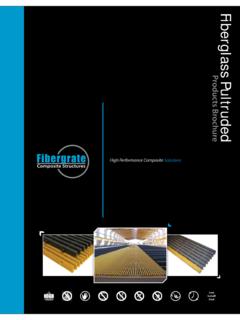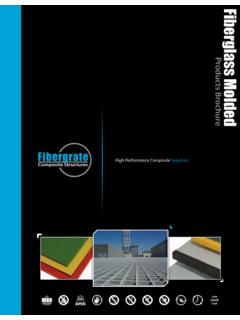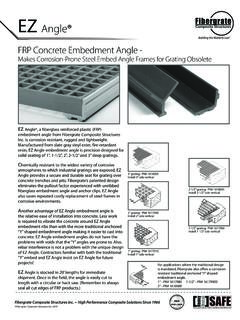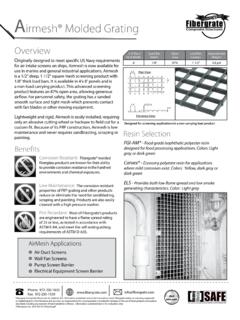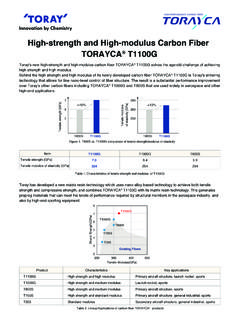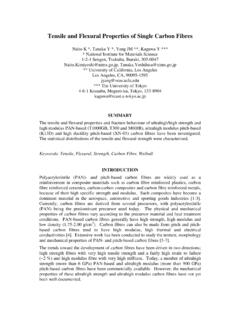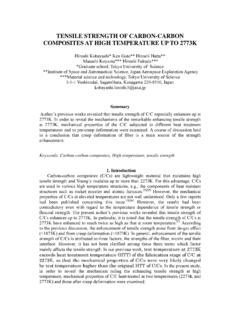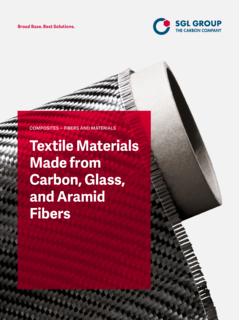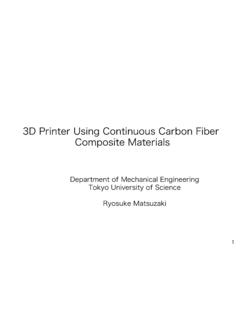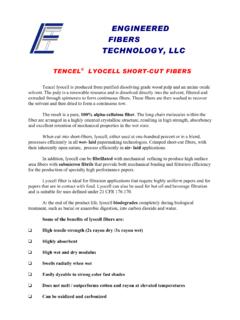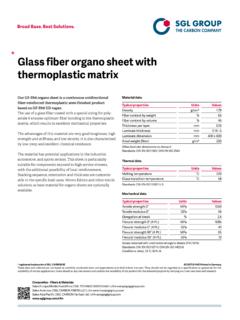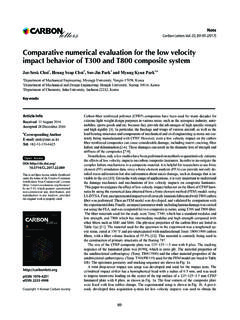Transcription of Dynaform - Fibergrate
1 | 800-527-4043 high Performance Composite SolutionsDynaform FRP Structural Shapes Design GuideComposite StructuresF i b e r g r a t Customary | 800-527-4043 Table of ContentsPultrusion Process.. 3 Resin Systems for Structural Shapes.. 4 Elevated Temperature Effects.. 4 Chemical Resistance Guide ..5 Structural Shapes ..5 Vinyl Ester Threaded Rod.. 7 Coupon Properties.. 8 Structural Shapes ..8 Pultruded Flat Sheet ..9 Vinyl Ester Threaded Rods and Nuts..10 Cross Sectional Tolerances ..11 Section Properties..15 Beams - Allowable Uniform Load Tables..25 Wide Flange Beams ..26 I Beams ..33 Channels ..42 Square Tubes ..51 Rectangular Tubes.
2 53 Structural Connections ..57 Stringer Design Tables..58 OSHA ..58 UBC ..59 Columns - Allowable Axial Load Tables ..60 Angles ..62 I Shapes ..71 Wide Flange Shapes..79 Square Tubes ..88 Rectangular Tube ..94 Round Tube.. | 800-527-4043 Pultrusion ProcessPultrusion is a continuous process of raw materials, typically resin and reinforcing materials, forming profiles of constant cross section in continuous length. Pultrusion gets its name from the method by which the profiles are made. Raw materials are literally pulled by what we call "the puller." "The puller" is the machine made up of pulling pads, which grip the product, and a drive system which keeps the product moving.
3 "The puller" is located just before the final cut-off process starts with the reinforcements. Typically, unidirectional glass roving is the fiber that runs along the length of the profile. Second, the fiberglass mat is added in, which is multidirectional reinforcement. Third is the resin, typically polyester or vinylester. The glass is "wet-out" with the liquid resin and pulled into a heated die. Just before all the material enters the die, surface veil may be added which enhances the final product's that all the reinforcements have been "wet-out" and pulled into a heated die, the curing takes place. All the resins used in the pultrusion process have a catalyst or hardener added when the resin is mixed.
4 This catalyst activated at about 200 F. Consequently, as the "wet-out" reinforcement pass through the heated die, the product changes from liquid to a solid profile with all the reinforcement laminated product exiting the die is pulled by "the puller", which upon exiting can be cut to the desired | 800-527-4043 TEMPERATUREISO(PN)/ISOFR(PF)VEFR(VF)Ulti mate Stress100 F85%90%125 F70%80%150 F50%80%175 FNot Recommended75%200 FNot Recommended50%Modulus of Elasticity100 F100%100%125 F90%95%150 F85%90%175 FNot Recommended88%200 FNot Recommended85%Standard Resin Systems for Structural ShapesStandard Polyester (ISO or PN)
5 Resin SystemThe STANDARD POLYESTER RESIN SYSTEM refers to a NON FLAME RETARDANT isophthalic polyester resin system. This resin system is manufactured in olive green and incorporates ultraviolet inhibitors. Polyester resins exhibit good corrosion resistance, good electrical properties, low thermal conductivity and excellent mechanical Retardant Vinyl Ester (VEFR or VF) Resin SystemThis resin system is manufactured from vinyl ester resin which exhibits higher strength, improved strength and stiffness retention at elevated temperatures, and improved corrosion resistance. This system also meets a maximum flame spread rating of 25 and is produced in beige and Temperature EffectsThe approximate retention of mechanical properties at elevated temperatures are:Flame Retardant Polyester (ISOFR or PF) Resin SystemThis resin system exhibits the same characteristics as the Standard Polyester resin system PLUS a flame spread rating of 25 or less when tested in accordance with ASTM E-84.
6 The FLAME RETARDANT resin system is manufactured in gray and | 800-527-4043 The data in this chemical resistance guide is based on field service performance, laboratory testing and extrapolated values from our resin manufacturers' recommendation. Data shown is intended as a guide only. It is recommended that for a specific application, testing be done in the actual chemical following conditions will effect the suitability of a specific resin laminate: Periodic changes in temperature Exposure to frequent splashes and spills Temperature spikes Exposure to intermittent splashes and spills Changes in chemical concentrations Frequency of maintenance wash down Combinations of chemicals Load bearing or non-load bearing requirements Exposure to vapors only Chemical EnvironmentMaximum Recommended Service Temperatures, FChemical EnvironmentMaximum RecommendedServiceTemperatures, FVEFRISO/ISOFRVEFRISO/ISOFRA cetic Acid, to 10%17080 Butyl AcetateNRNRA cetic Acid, to 50%180 NRButyl Alcohol80 NRAcetic Acid.
7 GlacialNRNRC alcium Carbonate170120 AcetoneNRNRC alcium Hydroxide140120 Aluminum Chloride170120 Calcium Hypochlorite120 NRAluminum Hydroxide140120 Calcium Nitrate170120 Aluminum Nitrate140120 Calcium Sulfate170120 Aluminum Sulfate170120 Carbon DisulfideNRNRA mmonium Chloride170120 Carbon Monoxide Gas170160 Ammonium Hydroxide, 5%140 NRCarbon Dioxide Gas170160 Ammonium Nitrate, to 50%170120 Carbon TetrachlorideAmmonium Nitrate, Saturated170NR Liquid or Vapor110 NRAmmonium Persulfate, to 25%14090 Chlorine, Dry Gas170 NRAmmonium Phosphate170120 Chlorine, Wet Gas170 NRAmmonium Sulfate170120 Chlorine Water140 NRAmyl Alcohol80 NRChloroformNRNRB arium Carbonate170120 Chromic Acid, to 5%110 NRBarium Chloride170120 Chromous Sulfate140120 Barium Sulfate170120 Citric Acid170120 BenzeneNRNRC opper Chloride170170 Benzene Sulfonic Acid 50%110 NRCopper Cyanide170170 Benzoic Acid170120 Copper Nitrate170170 Benzyl AlcoholNRNRC rude Oil, Sour170170 Borax170120 Cyclohexane, Liquid and Vapor170 NRBrine (Sodium Chloride Sol.)
8 170120 Diesel Fuel14090 Bromine, Liquid or VaporNRNRE thyl AcetateNRNRE thyl AlcoholNRNRP hosphoric Acid, Vapor170120 Ethylene Glycol170120 Potassium Aluminum Sulfate170120 Fatty Acids17080 Potassium Bicarbonate110100 Ferric Chloride170100 Potassium Carbonate, to 10%110 NRFerric Sulfate170110 Potassium Chloride170120 Formaldehyde110 NRPotassium Hydroxide140 NRFuel Oil14080 Potassium Nitrate170120 Gasoline, Aviation and Ethyl14080 Potassium Sulfate170120 Chemical Resistance Guide - Structural | 800-527-4043 Chemical Resistance Guide - Structural ShapesChemical EnvironmentMaximum Recommended Service Temperatures, FChemical EnvironmentMaximumRecommendedServiceTemp eratures, FVEFRISO/ISOFRVEFRISO/ISOFRG lucose170100 Propylene Glycol170120 Glycerine170100 Sodium Acetate170120 Hexane12090 Sodium Benzoate140120 Hydraulic Fluid (Glycol Based)
9 140 NRSodium Bicarbonate140120 Hydraulic Fluid Skydraul140 NRSodium Bisulfate170120 Hydrobromic Acid110 NRSodium Bisulfite170120 Hydrochloric Acid, up to 15%14080 Sodium Borate170120 Hydrochloric Acid, Concentrated110 NRSodium Bromide170120 Hydrogen Bromide, Dry Gas14080 Sodium Carbonate, to 10%14070 Hydrogen Bromine, Wet Gas140 NRSodium Chloride170120 Hydrogen Chloride, Dry Gas17080 Sodium Cyanide170120 Hydrogen Chloride, Wet Gas17080 Sodium Dichromate170120 Hydrogen Flouride, Sol or Vapor140 NRSodium Diphosphate170120 Hydrogen Peroxide, to 10%110 NRSodium Hydroxide, 10%140 NRHydrogen Sulfide, Dry Gas14080 Sodium Hypochlorite, to 5-1/4%11070 Hydrogen Sulfide, Wet Gas14080 Sodium Monophosphate170120 Isopropyl Alcohol80 NRSodium Nitrate170120JP-414080 Sodium Nitrite170120 Kerosene140110 Sodium Sulfate170120 Lactic Acid170120 Sodium Tetraborate140120 Lead Acetate170120 Sodium Thiosulfate140120 Linseed Oil170100 Soy Oil170100 Lithium Chloride170120 Stearic Acid170120 Magnesium Carbonate170120 StyreneNRNRM agnesium Chloride170120 Sulfamic Acid170120 Magnesium Hydroxide170100 Sulfated DetergentsNR120 Magnesium Nitrate170120 Sulfite Liquor160100 Magnesium Sulfate170120 Sulfur Dioxide.
10 Gas-dry170120 Mercuric Chloride170120 Sulfur Dioxide, gas-wet17070 Mercury Metal170120 Sulfur Trioxide, gas-wet or dry170 NRMethyl Ethyl KetoneNRNRS ulfuric Acid, to 25%17080 Mineral Oil170120 Tartaric Acid170120 MonochlorobenzeneNRNRT etrachloroethyleneNRNRN aphtha140120 TolueneNRNRN ickel Chloride170120 Trichloroethylene vaporNRNRN itric Acid, to 5%110100 Trisodium Phosphate170 NRNitric Acid, ConcentratedNRNRUrea, 35%110 NRNitric Acid, Vapor140100 Vinegar170150 Oleic Acid170120 Water, Distilled180150 Oxalic Acid170120 Water, Tap180120 Paper Mill Liquor100100 Zinc Chloride170120 Phenol Solution or VaporNRNRZinc Nitrate170120 Phosphoric Acid170100 Zinc Sulfate170120 Phosphoric Acid, Salts | 800-527-4043 Chemical Resistance Guide - Vinyl Ester Threaded RodsSOLUTIONMAXIMUM RECOMMENDED TEMPERATUREF /C H2SO4 - 25 %210/99 HCI - 20%210/99 HNO3 - Gas100/38 Acetic Acid - 25%210/99 Phosphoric Acid - 100%210/99 NaOH - 50%180/82 Sodium Carbonate - 35%180/82 NaCl - Saturated180/82 Ethanol - 10%120/49 Sodium Hypochlorate - 10%120/49 All AIK (SO4)

